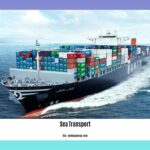Unlocking Efficiency: The Advantages of Water Transport
In today’s rapidly evolving global marketplace, the quest for efficiency is paramount. Businesses worldwide are constantly seeking innovative ways to optimize their logistics operations, reduce costs, and minimize their carbon footprint. Amidst this pursuit, water transport emerges as a compelling solution that offers a multitude of benefits. From its cost-effectiveness and environmental sustainability to its remarkable capacity, water transport presents a game-changing opportunity for businesses looking to streamline their operations. In this article, we delve into the extensive advantages of utilizing water transport and explore the immense potential it holds for driving efficiency in the transportation industry.
Key Takeaways:
- Water transport is cost-effective for long-distance travel, especially for heavy goods.
- It is an environmentally friendly mode of transportation, causing less pollution compared to other methods.
- Water transport has low maintenance costs and does not require extensive infrastructure.
- It is efficient in transporting cars and luggage, as they can be directly loaded onto boats.
Advantages of Using Water Transport

Water transport, as a mode of transportation, offers numerous advantages that make it a viable and efficient option for businesses in today’s global marketplace. From its cost-effectiveness to its environmental sustainability, water transport has proven to be an invaluable resource for moving goods and products across long distances. In this article, we will explore some of the key advantages associated with utilizing water transport.
Cost-Effectiveness and Efficiency
One of the primary advantages of water transport is its cost-effectiveness, especially for heavy goods and long-distance travel. Compared to other modes of transportation, such as air or road, water transport offers significantly lower freight rates. The ability to carry a large volume of goods on a single vessel translates to reduced transportation costs per unit, making it an attractive option for businesses looking to optimize their supply chain.
Moreover, water transport is highly efficient in moving cars and luggage as they can be directly loaded onto boats. This eliminates the need for intermediate handling and transfers, resulting in faster and smoother transportation. By utilizing water transport, businesses can streamline their logistics operations and reduce transit times, thus enhancing overall efficiency.
Environmental Sustainability
In today’s environmentally conscious world, the eco-friendly nature of water transport is a crucial advantage. Compared to other transportation modes, such as road or air, water transport has a significantly lower carbon footprint, causing less pollution. Vessels powered by sustainable fuels or electricity further minimize the environmental impact.
Water transport also contributes to the preservation of natural resources. By utilizing existing waterways, businesses can reduce the need for extensive infrastructure development, such as the construction of new roads or railways, which often result in deforestation and habitat destruction. Additionally, water transport helps alleviate congestion on highways, reducing traffic-related emissions and promoting sustainable urban development.
Low Maintenance and Infrastructure Requirements
Another advantage of water transport is its low maintenance cost and minimal infrastructure requirements. Unlike road or rail transportation, which necessitates constant repairs and upgrades, vessels and waterways require relatively less upkeep. This not only reduces maintenance expenses but also enhances the overall cost-effectiveness of water transport.
Additionally, water transport can utilize existing infrastructure, such as ports and harbors, with minimal modifications. This makes it a favorable choice for businesses operating in coastal areas or near navigable water bodies. By leveraging these readily available facilities, companies can avoid the substantial costs associated with constructing or expanding transport infrastructure.
Conclusion
In conclusion, the advantages of utilizing water transport are numerous and compelling. Its cost-effectiveness, environmental sustainability, and low maintenance requirements make it a highly efficient mode of transportation for businesses across various industries. By capitalizing on the benefits of water transport, companies can optimize their supply chains, reduce costs, and contribute to a greener and more sustainable global marketplace.
[advantages of using water transport]
Advantages of Traffic Light Control System
Explore the countless benefits of a traffic light control system, such as improved traffic flow, enhanced safety, and reduced congestion. Discover more about the advantages of a traffic light control system here.
Advantages of Traffic Management System
Curious about the advantages of a traffic management system? Discover how it can optimize traffic flow, minimize delays, and improve overall transportation efficiency. Uncover the benefits of a traffic management system here.
Advantages of Transport System
Unlock the advantages of a well-developed transport system, from enhanced connectivity and accessibility to efficient logistics and economic growth. Delve deeper into the advantages of a transport system here.
Advantages of Using Sea Transport
Embark on a journey to uncover the numerous advantages of utilizing sea transport, such as cost-effectiveness, capacity, and environmental sustainability. Dive into the advantages of using sea transport here.
Advantages of Water Transport
Dive into the vast benefits of water transport, including its ability to carry large volumes of goods, reduce road congestion, and lower carbon emissions. Discover the advantages of water transport here.
Advantages of Water Transport System
Discover the advantages of a water transport system, from its reliability and flexibility to its significant contribution to global trade and economic development. Explore the advantages of a water transport system here.
Capacity and Efficiency
Water transport provides numerous advantages in terms of capacity and efficiency, making it a highly viable mode of transportation in today’s global marketplace. Let’s explore how water transport outshines other modes of transportation in terms of carrying capacity, fuel consumption, operating cost, and accessibility to remote areas.
Advantages of Water Transportation
Higher Carrying Capacity: One of the key advantages of water transport is its significantly higher carrying capacity compared to road or rail transportation[^1^]. In fact, water transport can carry more than ten times the amount of freight that can be transported by road, making it an efficient option for large quantities of goods. This ability to transport a vast volume of goods on a single vessel helps reduce transportation costs per unit, making it a cost-effective solution for businesses[^1^].
Lower Fuel Consumption: Water transport boasts remarkably low fuel consumption per unit weight, making it both environmentally friendly and cost-effective[^2^]. This advantage arises from the fact that water transport vessels encounter far less resistance than vehicles on land. By strategically exploiting the natural buoyancy of water, ships can carry hefty cargo with minimal energy expenditure.
Lower Operating Cost: In addition to its low fuel consumption, water transportation also offers significantly lower operating costs per unit weight compared to road and rail options[^3^]. This translates to reduced expenses for businesses and proves to be a cost-saving benefit of water transport.
Accessibility to Remote Areas: Water transportation provides access to remote inland areas that may not be reachable by road or rail, allowing companies to penetrate markets that would otherwise be inaccessible[^4^]. This advantage opens up new possibilities for businesses, enabling them to tap into markets that offer potential for growth and expansion.
Disadvantages of Water Transportation
Despite the advantages, it is essential to acknowledge the limitations of water transportation. Understanding these drawbacks will help in making informed decisions regarding transportation choices.
Slower Speed: Water transport, by nature, tends to be slower compared to road and rail transport[^5^]. Shipping goods by water takes a longer time, which could impact time-sensitive deliveries. However, for businesses with longer lead times or non-urgent shipments, water transport can still be a highly efficient and cost-effective option.
Weather Dependency: The operations of water transport can be strongly influenced by weather conditions such as storms, floods, and heavy rains. Adverse weather conditions can lead to disruptions in shipping schedules, impacting the efficiency of delivery times[^5^]. Businesses considering water transport should be mindful of these weather-dependent challenges and incorporate contingency plans to mitigate any potential delays.
Limited Infrastructure: Water transportation relies on the availability of rivers, canals, and navigable waterways, which may be limited in certain regions[^5^]. This limitation restricts the accessibility of water transport to specific areas, making it necessary to evaluate the feasibility of water transport for specific routes and regions.
Regulation of Water Transport
Water transport is regulated by various national and international bodies, ensuring safety, security, and environmental protection in its operations[^6^]. Organizations such as the International Maritime Organization (IMO) oversee international regulation, aiming to maintain high standards and uphold the sustainability of water transport. Compliance with these regulations ensures the credibility of water transport services and provides peace of mind to businesses utilizing this mode of transportation.
Key Takeaways:

- Water transport offers higher carrying capacity, making it efficient for transporting large quantities of goods.
- Its low fuel consumption per unit weight makes water transport both cost-effective and environmentally friendly.
- Water transportation boasts lower operating costs compared to road and rail transportation.
- It provides accessibility to remote inland areas, unlocking new market opportunities.
- However, water transport may be slower compared to other modes, and its operations are weather-dependent.
- Limited infrastructure for water transportation in certain regions should be considered.
- Compliance with regulations ensures safety, security, and environmental sustainability in water transport operations.
Sources:
– Cloud.Uobasrah.Edu.Iq
– Sugamgroup.Com
– Sciencedirect.Com
Global Connectivity and Accessibility
Water transport plays a crucial role in facilitating global connectivity and accessibility, providing businesses with efficient and cost-effective means of transporting goods across various regions. With its extensive advantages, water transport has become an essential component of the global marketplace.
Advantages of Water Transportation
Water transportation offers several key advantages that contribute to global connectivity and accessibility:
1. Higher Carrying Capacity
– Freight carrying capacity by water is more than ten times higher than carrying capacity by road, making it a more efficient mode of transportation for large quantities of goods (Source: cloud.uobasrah.edu.iq).
2. Lower Fuel Consumption
– Water transport has very low fuel consumption per unit weight, making it more environmentally friendly and cost-effective (Source: cloud.uobasrah.edu.iq).
3. Lower Operating Cost
– The operating cost per unit weight is very low for water transportation compared to road and rail transportation (Source: cloud.uobasrah.edu.iq).
4. Accessibility to Remote Areas
– Water transportation provides access to remote inland areas that may not be reachable by road or rail, allowing companies to penetrate markets that would otherwise be inaccessible (Source: sugamgroup.com).
Disadvantages of Water Transportation
While water transportation offers numerous advantages, it also faces certain limitations that can impact global connectivity and accessibility:
1. Slower Speed
– Water transport is generally slower compared to road and rail transport, as shipping goods by water takes a longer time (Source: sugamgroup.com).
2. Weather Dependency
– Water transport operations can be affected by weather conditions such as storms, floods, and heavy rains, leading to disruptions in shipping schedules (Source: sugamgroup.com).
3. Limited Infrastructure
– Water transportation requires the availability of rivers, canals, and navigable waterways, which may be limited in certain regions, thereby limiting the accessibility of this mode of transport (Source: sugamgroup.com).
Regulation of Water Transport
To ensure safety, security, and environmental protection in water transportation operations, various national and international bodies regulate water transport. One prominent organization overseeing international regulation is the International Maritime Organization (IMO) (Source: sciencedirect.com).
Key Takeaways:
- Water transport offers higher carrying capacity, lower fuel consumption, and lower operating costs.
- It provides accessibility to remote areas that may not be reachable by road or rail transport.
- However, water transport is slower, weather-dependent, and requires specific infrastructure.
- International bodies like the International Maritime Organization regulate water transport for safety and environmental sustainability.
Reduced Traffic Congestion and Road Maintenance
Traffic congestion and road maintenance are ongoing challenges for transportation systems worldwide. As cities become more populated and global trade continues to grow, finding solutions to alleviate these issues is crucial. One effective solution lies in utilizing water transport as an alternative mode of transportation. In this article, we will explore the advantages of water transport and how it can contribute to reduced traffic congestion and road maintenance.
Water transport, including shipping and barges, offers unique benefits that cannot be easily replicated by other modes of transportation. By taking advantage of waterways, businesses can significantly reduce the number of goods transported on congested roads. This reduction in road traffic not only alleviates congestion but also improves road safety and reduces the need for costly road maintenance.
Advantages of Water Transport for Reducing Traffic Congestion:
-
Higher carrying capacity: Water transport has a significantly higher carrying capacity compared to road transport. According to cloud.uobasrah.edu.iq, freight carrying capacity by water is more than ten times higher than carrying capacity by road. By utilizing water transport for large quantities of goods, businesses can significantly reduce the number of trucks on the road, freeing up space and reducing congestion.
-
Lower fuel consumption: Water transport is highly fuel-efficient, especially when compared to road transport. According to the same source, water transport has very low fuel consumption per unit weight. This not only reduces operating costs but also contributes to lower carbon emissions and a smaller environmental footprint.
-
Accessibility to remote areas: Water transport provides access to remote inland areas that may not be reachable by road or rail. This opens up new markets for businesses and encourages economic growth in regions that were previously underserved. By utilizing waterways, companies can extend their reach without adding to road congestion in heavily populated urban areas.
Advantages of Water Transport for Reduced Road Maintenance:
-
Lower wear and tear on roads: The use of water transport reduces the wear and tear on roads caused by heavy trucks carrying goods over long distances. Water transport allows for the transportation of a large volume of goods on a single vessel, reducing the need for trucks to travel on roadways. This decreases the frequency of road maintenance, saving both time and expenses for governments and transportation authorities.
-
Reduced infrastructure burden: Water transport requires relatively less infrastructure compared to other transport methods like rail and road transport. By making use of existing navigable waterways and ports with minimal modifications, businesses can avoid costly investments in new road infrastructure. This not only saves money but also minimizes disruptions caused by construction and repairs, leading to smoother traffic flow and reduced road maintenance needs.
In conclusion, utilizing water transport offers numerous advantages in terms of reducing traffic congestion and road maintenance. By taking advantage of the higher carrying capacity, lower fuel consumption, and accessibility to remote areas offered by waterways, businesses can significantly reduce the number of trucks on the road. This reduction in road traffic not only alleviates congestion but also decreases wear and tear on roads, leading to reduced road maintenance needs. With its sustainability, cost-effectiveness, and capacity to compete with other modes of transport, water transport proves to be an efficient and reliable solution for addressing the challenges of traffic congestion and road maintenance in today’s global marketplace.
Key Takeaways:
- Water transport, such as shipping and barges, provides unique benefits that reduce traffic congestion and road maintenance.
- Water transport has a significantly higher carrying capacity compared to road transport, reducing the number of trucks on congested roads.
- Water transport is highly fuel-efficient, contributing to lower carbon emissions and a smaller environmental footprint.
- Water transport provides access to remote inland areas, allowing businesses to penetrate new markets without adding to road congestion.
- Utilizing water transport results in lower wear and tear on roads, reducing the frequency of road maintenance.
- Water transport requires relatively less infrastructure compared to other modes of transport, saving costs and minimizing disruptions from construction and repairs.
FAQ
Q1: What are the advantages of using water transport?
A1: Water transport offers several advantages, including lower costs for traveling long distances, especially for heavy goods. It is also a natural and eco-friendly mode of transportation with lower pollution compared to other modes. Water transport has low maintenance costs and does not require extensive infrastructure. Additionally, it is efficient in moving cars and luggage as they can be directly loaded onto boats.
Q2: How does water transport compare to other modes of transportation in terms of carrying capacity?
A2: Water transport has a higher carrying capacity compared to road transport, making it more efficient for transporting large quantities of goods. It can carry over ten times more freight than road transport (Source: cloud.uobasrah.edu.iq).
Q3: How does water transport contribute to environmental sustainability?
A3: Water transport has lower fuel consumption per unit weight compared to other modes of transportation, making it more environmentally friendly. Its low fuel consumption reduces carbon emissions and makes it a cost-effective option (Source: cloud.uobasrah.edu.iq).
Q4: What are the limitations of water transport?
A4: Water transport is generally slower than road and rail transport, as shipping goods by water takes a longer time. It is also weather-dependent, and operations can be affected by adverse weather conditions such as storms, floods, and heavy rains. In addition, water transportation requires the availability of rivers, canals, and navigable waterways, which may be limited in certain regions, affecting the accessibility of this mode of transport.
Q5: What role do regulations play in water transport?
A5: Water transport is regulated by various national and international bodies to ensure safety, security, and environmental protection. International regulation is overseen by organizations like the International Maritime Organization (IMO). These regulations aim to maintain the safety and sustainability of water transportation operations (Source: sciencedirect.com).
- Unveiling Bernhard Caesar Einstein’s Scientific Achievements: A Legacy in Engineering - July 15, 2025
- Uncover who is Jerry McSorley: CEO, Family Man, Business Success Story - July 15, 2025
- Discover Bernhard Caesar Einstein’s Scientific Contributions: Unveiling a Legacy Beyond Einstein - July 15, 2025















